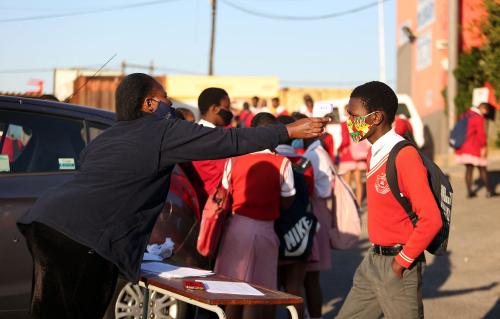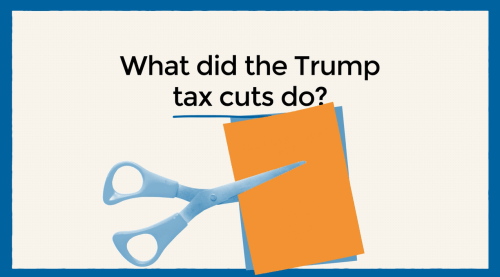State and local governments are significant players in the U.S. economy. Employment by state and local governments represents about 13 percent of total employment in the U.S.—more than the federal government. State and local tax revenues represent about 9 percent of GDP.
And unlike the federal government, state and local governments generally have to balance their operating budgets; they can’t borrow to finance large deficits. This Q&A examines the fiscal impact that COVID-19 has had on state and local governments and is drawn from “Fiscal Effects of COVID-19,” presented at the Brookings Papers on Economic Activity on September 24, 2020.
How has COVID-19 affected state and local government finances?
As in other economic downturns, the pandemic has reduced state and local revenues, but this time is different. Declines in income tax revenues are likely to be smaller than projections based on historical experience because employment losses have been unusually concentrated on low-wage workers (who pay less income taxes than higher-wage workers), the stock market has held up so far (sustaining taxes on capital gains), and the federal government has increased and expanded unemployment insurance benefits and grants to business, which will shore up taxable income. On the other hand, declines in sales and other taxes and fees are larger than historical experience would suggest, because consumption has fallen so sharply and people are staying home—meaning that revenues from taxes and fees on hotels, tolls, airports, and motor fuel have plummeted.
We project that state and local government revenues will decline $155 billion in 2020, $167 billion in 2021, and $145 billion in 2022—about 5.5 percent, 5.7 percent, and 4.7 percent, respectively—excluding the declines in fees to hospitals and higher education. Including those fees to hospitals and higher education would bring these totals to $188 billion, $189 billion, and $167 billion.
While federal aid to state and local governments this year has exceeded projected revenue losses, that aid is only one-time, and state and local governments are expected to face shortfalls for many years. Without promises of further aid, these governments are likely to cut spending now to prepare for future imbalances. Furthermore, state and local governments are at the forefront of the response to the pandemic in their communities and will likely need to increase their typical spending to provide crucial public health services and help communities adapt to social distancing guidelines. One lesson from the years following the Great Recession is that cutbacks by state and local government can be a substantial restraint on the vigor of the economic recovery, and so ensuring that state and local governments have enough funding is important both for ensuring that needed services are provided and that the economic recovery is as robust as possible.
How has COVID affected state and local income tax revenues?
We project that state and local income tax revenues will decline 4.7 percent in 2020, 7.5 percent in 2021, and 7.7 percent in 2022— $22 billion, $37 billion, and $40 billion, respectively. These moderate declines— especially relative to the declines that would have been estimated based on past recessions—reflect the low incomes of most of the unemployed and the large, taxable fiscal stimulus mentioned above. In fact, without the CARES Act, income tax revenues would have declined an additional $13 billion in 2020, $8 billion from unemployment insurance and $5 billion from PPP (Paycheck Protection Program).
There is a lot of variation across the states in the income tax revenue losses associated with COVID, due to variation in unemployment rates, the generosity of unemployment insurance benefits, and the importance of non-wage income to the tax base. New Hampshire, California, New Jersey, and New York are projected to record the largest 2020 percentage declines, with income taxes falling 9 percent, 8.5 percent, 8 percent, and 6.7 percent, respectively. In contrast, Illinois, Kansas, Kentucky, North Carolina, and West Virginia are projected to suffer declines of less than 1.5 percent.
How has COVID affected revenues from sales taxes?
Forty-six states impose general sales taxes and, on average, these taxes account for about one quarter of state and local tax revenue. Some localities impose their own sales tax on top of or in lieu of the state sales tax. Because the sales tax is based on the dollar value of sales, sales tax revenues move proportionally with consumption of taxed items. But consumer spending during the pandemic was unusual. Much of the decline affected services, such as hairdressing, which are less likely to be taxed than goods. There were large increases in purchases of food at the grocery store, which is typically not subject to the sales tax, and large declines in spending at restaurants and hotels, which are often taxed more heavily than other things.
In aggregate, sales taxes look to decline $49 billion this year, $45 billion next year, and $46 billion in 2022, in part reflecting lower price levels and in part because of changes in demand. Looking across the states, the largest percentage declines are projected in the District of Columbia (18 percent) and Rhode Island (16 percent), while the smallest declines are in Alabama, Idaho, and Arkansas (4 percent, 5 percent, and 6 percent, respectively).
These projections may be too pessimistic. As the effects of social distancing lessen, some lost spending could be made up, particularly after savings have increased from people staying home—cars not purchased and trips not taken may have been delayed, rather than canceled altogether.
What about taxes on corporations, property taxes, and fees?
State corporate tax collections make up only a small part of state and local revenues but are particularly vulnerable to economic downturns. We project that they will decline $2 billion in 2020, $29 billion in 2021, and $14 billion in 2022. Property taxes make up 22 percent of own-source revenues (that is, excluding grants from the federal government), but house prices have held up well so far and future declines in property taxes do not appear to be significant.
As people stay home, revenues collected from sources like highway tolls and charges for public parks may fall. Pandemic-related declines in charges and fees will likely account for a loss of $82 billion this year, $55 billion next year, and $45 billion in 2022. These declines disproportionately come from declines in transportation-related revenues, a big difference from prior recessions.
The pandemic could also lower fees to public hospitals and institutions of higher education by $33 billion this year, $22 billion in 2021, and $22 billion in 2022, although these fees are typically rendered in exchange for services paid for by state and local governments. For example, the sharp decline in health expenditures in the spring meant that health care facility revenues plunged. To the extent that public hospitals laid off workers, reduced hiring and hours, or cut back on supplies, these revenue losses may have been offset at least in part by a decline in spending.
What has the federal government done in response, so far?
States and localities are due to receive over $200 billion in federal aid this year. The largest portion of that aid is $150 billion through the Coronavirus Relief Fund. The CARES Act also provided $25 billion in aid to public transit agencies, $13 billion to K-12 education, and roughly $6.5 billion to public colleges and universities. The CARES Act includes $175 billion in aid to health care providers, $35 billion of which we estimate will go to public hospitals and community health centers. In addition, the Families First Coronavirus Response Act raised the federal share of Medicaid spending by 6.2 percentage points for the duration of the public health emergency. This increase appears to be more than enough to fund states’ higher Medicaid expenditures expected as a result of the pandemic, leaving about $24 billion of flexible funding in 2020, $19 billion in 2021, and $9 billion in 2022.
At least for 2020, federal aid seems large enough to offset the revenue losses state and local governments are likely to experience. Should the economy remain depressed in the coming years, however, these governments will need additional aid in order to avoid cutting services or raising taxes and impeding the recovery.
Furthermore, even if state and local governments don’t cut back on spending in the aggregate, changes in spending needs brought on by the pandemic could force these governments to confront tough budget choices and perhaps cut essential services. For example, if providing decent virtual education requires hiring more staff and providing equipment to students, or if demand for mental health services or services for the elderly rise as a result of the pandemic, then pre-COVID levels of spending may not be enough.
Different states are also experiencing varying degrees of fiscal stress. States like Nevada, Washington, California, Florida, and New York show the largest revenue declines in 2020, while states like Kansas, New Hampshire, Mississippi, and Wyoming show the smallest. Since the $150 billion Coronavirus Relief Fund gave each state a minimum of $1.25 billion, some states have received more than enough funding to cover their losses while others are likely to face budget shortfalls even without significant increases in COVID-related spending. For example, Vermont received aid (other than for hospitals and higher education) equal to 23 percent of its general own-source revenues; New York, which was much harder hit by the pandemic, received only 6 percent.
In addition, the Federal Reserve established the Municipal Liquidity Facility. The facility aims to ease the cash flow pressures on state and local governments by purchasing short term municipal debt. Although the facility made only two loans, it has contributed to the smooth functioning of the municipal bond market in which states and localities can now borrow at interest rates which are at, or near, historic lows.
What effect do low interest rates have on state and local governments?
State governments are both borrowers and savers. The saving is mostly in the form of contributions to state and local employee pension funds; the borrowing is through the issuance of municipal debt, mostly to finance long-term capital projects. On net, state and local governments are savers. According to the Census of Governments for 2017, total state and local government debt equaled $3 trillion in 2017, while total financial assets were $6.9 trillion. Low interest rates, then, mean smaller returns to state and local government savings.






Commentary
How much is COVID-19 hurting state and local revenues?
September 24, 2020